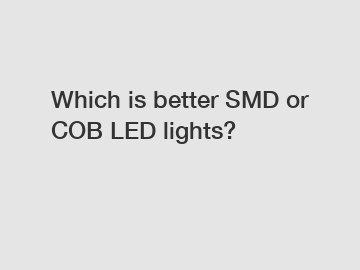Which is better SMD or COB LED lights?
When it comes to choosing the right LED lights for your home or business, the decision between SMD and COB LED lights can be a tough one. Both types of LED lights have their own set of advantages and disadvantages, so it's important to weigh the pros and cons before making a decision. In this blog post, we'll take a closer look at the differences between SMD and COB LED lights to help you determine which is better for your specific lighting needs.
SMD stands for Surface Mounted Device, and it refers to a type of LED where the diode is mounted directly onto a circuit board. SMD LEDs are known for their brightness and energy efficiency, making them a popular choice for a variety of lighting applications. On the other hand, COB, which stands for Chip on Board, refers to a type of LED where multiple diodes are packaged together as one lighting module. COB LEDs are known for their high lumen output and excellent color rendering, making them ideal for applications where a high level of light intensity is required.
One of the key differences between SMD and COB LED lights is the way in which the diodes are arranged. With SMD LEDs, each diode is mounted individually onto the circuit board, which allows for more flexibility in design and placement. COB LEDs, on the other hand, feature multiple diodes packaged together in one module, which results in a more compact and uniform light source.

In terms of energy efficiency, both SMD and COB LED lights are highly efficient compared to traditional incandescent or fluorescent lighting. However, COB LEDs tend to be slightly more energy efficient than SMD LEDs due to their design and construction. COB LEDs also have a higher lumen output, which means they can produce more light using less energy.
When it comes to color rendering, COB LEDs are often preferred over SMD LEDs. COB LEDs have a higher color rendering index (CRI), which means they are able to render colors more accurately and with greater clarity. This makes COB LEDs ideal for applications where color quality is important, such as in retail settings or art galleries.
Another factor to consider when choosing between SMD and COB LED lights is the level of heat produced. COB LEDs tend to produce more heat than SMD LEDs, which can affect the lifespan and performance of the light. To counteract this, COB LED lights are often equipped with heat sinks or cooling fans to help dissipate heat and prolong the life of the light.
In terms of cost, SMD LEDs are generally more affordable than COB LEDs, making them a popular choice for budget-conscious consumers. However, it's important to keep in mind that COB LEDs offer superior performance and longevity, which can make them a more cost-effective choice in the long run.
Ultimately, the choice between SMD and COB LED lights will depend on your specific lighting needs and preferences. If you require a high level of brightness and color accuracy, COB LEDs may be the better option for you. On the other hand, if you're looking for a more affordable and versatile lighting solution, SMD LEDs may be the way to go.
In conclusion, both SMD and COB LED lights have their own set of advantages and disadvantages. It's important to consider factors such as energy efficiency, color rendering, heat production, and cost when making a decision. By weighing the pros and cons of each type of LED light, you can choose the option that best suits your individual lighting needs. Whether you choose SMD or COB LED lights, you can rest assured that you're investing in a lighting solution that is energy-efficient, long-lasting, and environmentally friendly.
If you want to learn more, please visit our website cob chip manufacturer, cree led diode, 150w cob led.
221
0
0


Comments
All Comments (0)